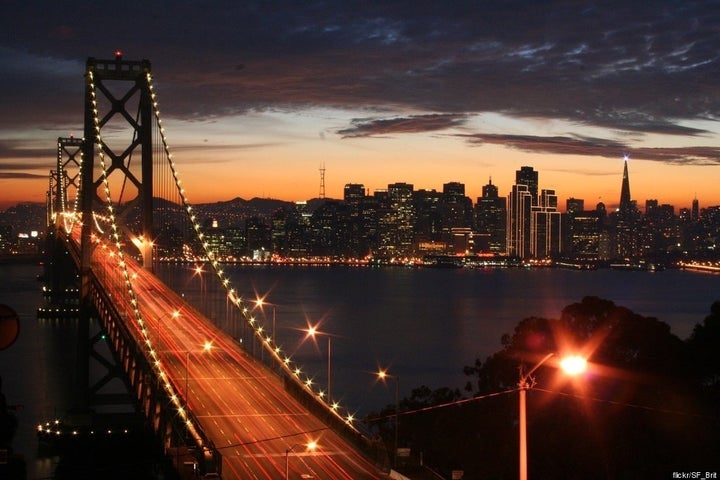
In August I posted an essay on Huffington Post asking the question why, as opposed to how, America destroyed its great cities in the second half of the 20th century. I listed various "suspects," including the impact of the automobile, as the automobile was certainly one of the means by which American cities were destroyed, and also possibly one of the causes.
In a basic physical sense, expressways ripped apart American cities. With respect to economics, they moved industrial activity and other businesses from proximity to ports and railroads to interchanges outside cities. As for demographics, they lured middle-class white Americans out of the city and to the suburbs.
Earl Swift's new book, The Big Roads: The Untold Story of the Engineers, Visionaries, and Trailblazers Who Created the American Superhighways, explains from the very beginning of the automotive age how expressways, turnpikes, interstates, and freeways came to be. This book also sheds light on the reasons why America was willing to, or persuaded to allow, these roads to destroy so much in the way of assets that were embedded in cities.
As recounted in the book, the story begins when, simply put, there were no roads in the country suitable for cars, and when even few streets in cities had hard surfaces. To understand the missionary zeal with which engineers and other road-builders applied themselves to crisscrossing America with roads, it's important to remember the dramatic benefits cars and trucks brought to rural America and what enthusiasm early car-owners had for their machines.
The book focuses on personalities, many of them "large." These include Carl Fisher, best known today, if known at all, as the founder of the Indianapolis Motor Speedway, but who a century ago was the country's leading proponent of building better roads. He also made a fortune selling a gas-powered headlight, and later developed Miami Beach.
But the ultimate stars of the book are engineers and bureaucrats, none more important than Thomas MacDonald, who headed the federal government's Bureau of Public Roads, the predecessor of the Federal Highway Administration, from 1919 to 1953. MacDonald, known to all as the "Chief," was one of a breed that seems hardly to exist anymore, the universally respected federal civil servant -- a technocrat before the word was in common usage -- who wielded tremendous power regardless what party was in power.
It was under MacDonald that the Bureau in the '30s and '40s developed plans for what became the interstate highway system, although MacDonald himself retired a few years before Congress passed and President Dwight Eisenhower signed the Federal-Aid Highway Act of 1956, which finally provided a means to fund the interstates.
This is where the story gets interesting when it comes to the fate of the cities. The key issue is why expressways invade American cities rather than go around them, as is generally the case in Europe. In Europe limited access highways typically connect with a ring road; within the ring road, cars travel on boulevards and streets, public transit was maintained and expanded, and cities were not destroyed to build highways.
Bringing the highways into the city was a momentous decision, but it was never a decision that the country debated in any meaningful way.
Before the federal government financed the interstate program, local and state governments had already made their own decisions to build limited access highways through cities. Think of Robert Moses' parkways in New York, or the Pasadena Freeway in L.A. These ideas were current when the Bureau developed its vision for a national road system, as expressed in its 1943 report, "Interregional Highways," which called for expressways in cities without designating specific routes. Local governments concurred, under the profoundly mistaken view that their cities would revive if they were connected to the suburbs by high-speed roads.
In 1944 Congress passed a highway bill that for the first time called for a "National System of Interstate Highways," and which provided that one-quarter of each year's federal appropriation to the states for roads that would be used in cities.
That was 12 years before Congress funded the interstate highways. During that time, a counter-attack, most identified with Lewis Mumford, developed against urban expressways, but when Congress in 1956 approved funding for the interstates, the concepts from the 1944 bill were still in the plan. Yet there was no debate on the issue; the idea of cutting interstates through cities was buried in the bill.
So buried that the man who signed the bill, President Eisenhower, was surprised -- and appalled -- to learn a few years later, purportedly in 1959 when he was shocked to find an interstate being built in the nation's capital, that the bill he signed funded urban highways.
The 1956 act unleashed expressways on cities all over America. In many places, however, there was resistance, and activists and community organizations blocked crosstown highways from being built from Greenwich Village to Beverly Hills. In his book, Swift focuses on the long fight in Baltimore to stop I-70 from crashing through the city. The fight was successful, but not before the threat of the coming road caused much of the city to be abandoned.
Fifty years later, among the most important movements in the re-urbanizing of America are freeway removal, such as in Boston with the Big Dig, and efforts, such as with the Hollywood Freeway in Los Angeles, to cover over sunken roads to reclaim urban land. It took decades to build the freeways through cities, and it will take decades to repair the damage.
The Big Roads: The Untold Story of the Engineers, Visionaries, and Trailblazers Who Created the American Superhighways, by Earl Swift; Houghton Mifflin Harcourt; 375 pages, $27.00.
Frank Gruber writes a weekly column on local politics, which often involve land use issues, for the Santa Monica Lookout News, a news website. His first book, Urban Worrier: Making Politics Personal, was published by City Image Press.